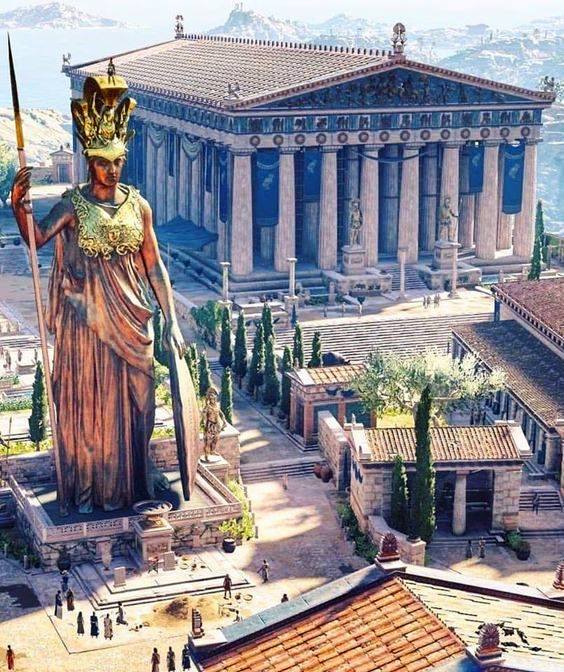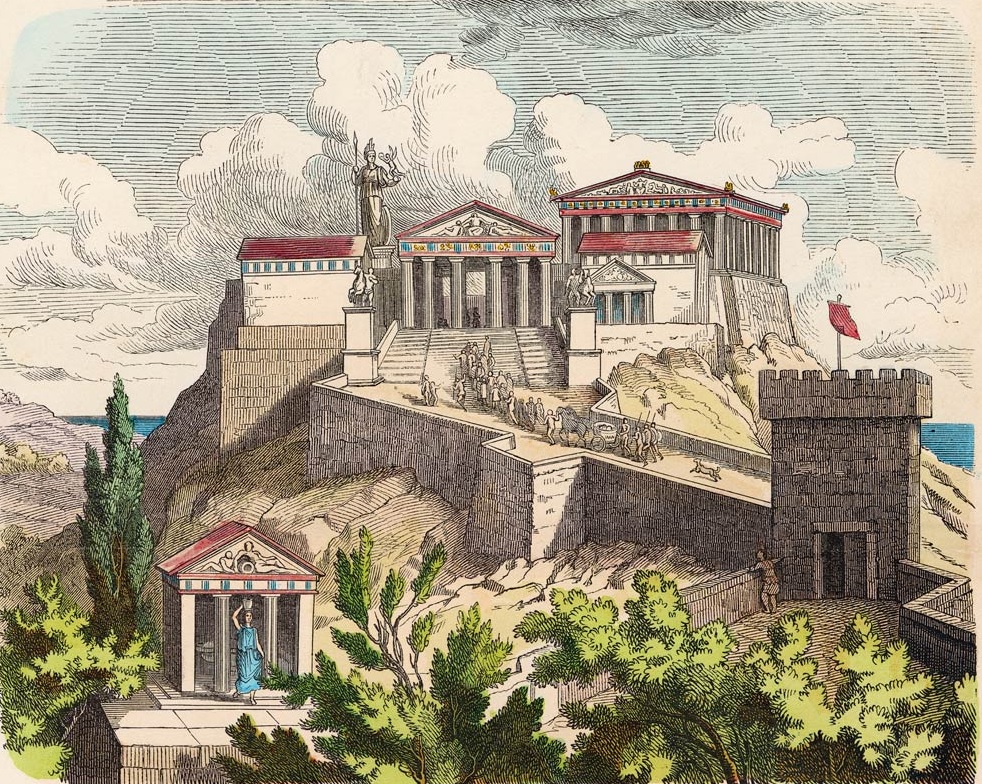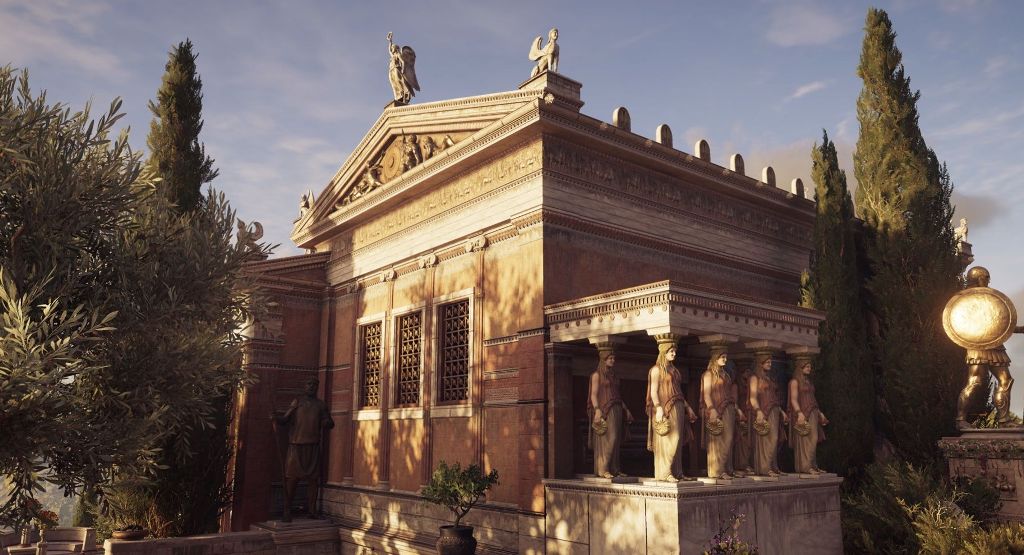Acropolis
The Acropolis, in Athens, is a small limestone hill rising to a height of 500 ft. above the sea; in ancient times, it was the holiest shrine of the Goddess Athena. It's been occupied continuously since the late Stone Age, perhaps from 4000 BC, but from the first three millennia of this long period hardly anything remains but some of the pottery and tools used by those who lived there. At the end of the Bronze Age, c.1200-1100 BC, when Athens was threatened by invasions from the north, the hill was surrounded by a massive wall of Cyclopean masonry, resembling the walls at Tiryns and Mycenae. This wall dates from the time of Theseus, the Athenian hero in Greek legend who overcame the Cretan minotaur, and who as king of Athens united all of Attica under his sceptre.
Contents
It must be noted that in the 17th century, the Acropolis had not suffered significant damage on account of any war, and therefore it appears with much greater integrity in the game world; for example, the Parthenon still has it's roof and statuary intact, while many other buildings are still in good condition.
Early Ruins
The early citadel had a fortified entrance at the west and a postern gate on the northeast side. An abundant water supply was provided by a concealed fountain, reached through a cleft in the rock by a curiously constructed stairway. The water level was 110 ft. below the Acropolis.
The fortification wall, many times rebuilt, was formidable, and so high as to shut out the view except at one point at the southwest corner. When the Persians attacked the Acropolis in 479 BC, they were unable to gain possession of it by direct assault, although it was defended chiefly by old men. In the end, the Persians effected an entrance only by secret stairs originally built to reach the underground fountain. The citadel was then sacked, the temples were plundered and burned, the whole area reduced to ruins, and the early Parthenon, then in the course of construction, was destroyed by heat from the burning scaffold the Persians had built during the siege. When the Greeks returned after their victory over the Persian fleet at Salamis, they rebuilt the wall using the unfinished column drums of the temples as facing the north side, where they still remain.
For the next thirty years there was little building activity on the Acropolis, but beginning in the middle of the 5th century BC, a series of new buildings were erected of Pentelic marble (from Mount Pentelicus). The four buildings described in the following paragraphs, together with minor monuments and statues, were constructed between 450 and 400 BC, and at this time the citadel received the general character it retained until the end of the Classical Era. The thirty years, c.460-430, during which the personality of Pericles was dominant, constitute the Golden Age of ancient Athens.
The Propylaea
The principle entrance to the Acropolis is on the west, through a monumental gateway of marble called the Propylaea. The present building, erected over the ruins of an earlier entrance and designed by the architect Mnesicles, was begun in 437 BC and was almost finished five years later. The gateway proper consists of five openings for doors, the central one having a width of nearly 14 ft. The facade is in the form of a Doric colonnade with six columns approached by four steps, the lowest one of which is of dark grey limestone from Eleusis.
There is a similar colonnate on the inner side, facing the Acropolis, and a broad ramp leading through the centre of the building is flanked by three Ionic columns on either side. To the north and south of the west facade are two wings, each approached through three Doric columns of smaller dimensions than those of the main facade. The northwest wing was used as a picture gallery.
Mnesicles' original plan called for a building much larger than the one constructed, but the growing opposition to Pericles' progressive policies and the outbreak of the Peloponnesian War in 433 BC, probably caused the curtailment of his plan, and the building remains an unfinished masterpiece of architecture.
To the south and west of the Propylaea (on the right hand side in the image shown) stands the small marble temple of Athena Nike, popularly known as the temple of Nike Apteros, or Wingless Victory. It has four Ionic colums at either end which support the architrave, and above this is a frieze sculpted in relief with scenets of mythological and historical battles. The plans of this building were originally made by Callicrates after the middle of the 5th century BC. Beneath the marble temple are the remains of an earlier, much smaller shrine and an archaic altar, showing the high antiquity of the cult of Athena on this spot. A sculptured parapet of marble surrounds the bastion on three sides, and on all of the preserved slabs there are carved figures of winged victories in a variety of poses.
The Parthenon
The visitor entering the Acropolis through the inner facade of the Propylaea has the northwest corner of the Parthenon immediately in view. This temple was designed to be seen from this angle, for it appears to best advantage rising in sober grandeur above the surrounding monuments. It was constructed in 447-438 BC, under the personal direction of Pericles, by the two architects Ictinus and Callicrates. The sculptural decoration was probably designed by Pericles' friend Phidias, who made the colossal cult statue of Athena in ivory and gold for the cella, or inner shrine, of the temple.
The Parthenon is universally accepted as being the most nearly perfect building ever erected. Although essentially a Doric structure, it has some Ionic features, such as the running frieze above the cella walls. A colonnade, consisting of seventeen columns along eitehr side and eight at either end, surrounds the cella. The three steps leading from the ground to the floor level curve gently upward toward the middle, and all the columns have a slight inward inclination.
The Doric frieze over the columns has sculptured metopes (square spaces) depicting contests between gods and giants; other mythological scenes, consisting of several metopes separated by trigylphs (three verticle grooves), represent single combats. The frieze over the cella walls presents a continuous picture of the Panathenaena Procession in honour of Athena. Nude young Athenians mounted on lively horses, chariots drawn by teams of four horses and trains of sacrificial animals, with men and women carrying gives to the goddess make up the procession. A group of deities, represented at the east end, stands ready to receive the worshippers.
The two gables of the temple are decoracted with marble statuary in the round; on the east gable is depicted an assembly of gods witnessing the miraculous birth of Athena from the head of Zeus. The time of day is indicated by a representation of the Moon's horses disappearing beneath the horizon in the left corner of the gable, while on the opposite side the impetuous steeds of the Sun come into view. The west gable shows the contest between Poseidon and Athena, won by Athena, for the possession of Attica. The two deities are represented holding their specific gifts, Poseidon the horses and Athena the olive tree, whereby they claim possession of the land.
The Parthenon was built to house the masterpiece of Phidias, the statue of Athena constructed of gold and ivory over a frame of wood. The total height is 40 ft. In the time of the game world, 1650, the statue remains in excellent condition: the goddess is shown standing armed with shield and helmet, and in her right hand, resting on a pillar, is a figure of Victory.
The Erechtheum
The foundation of another early temple, also dedicated to Athena, lies a little to the north of the Parthenon ... and between this foundation and the north wall of the Acropolis stands the Erechtheum. This architectural gem, executed in the Ionic order, was completed after the death of Pericles, but it undoubtedly formed a part of his plan for the rebuilding of all the major monuments of the Acropolis in Pentelic marble. The Erectheum was the joint cult temple of many deities. Chief among these was Athena, who shared her shrine with Poseidon, her erstwhile rival, and with Erechtheus, the early king of Athens from whom the building got its name. Within the Erechtheum was Poseidon's salt well which, according to myth, came into existence when the god of the sea struck the rock of the Acropolis with his trident.
Because of the multiple purposes it was to serve, the temple was designed as a composite structure, with two major entrances, each from a porch with Ionic columns. The doorway of the north porch, exquisitely carved with rosettes and delicate moldings, is the best example of architectural decoration preserved from the Periclean age. On the south side of the building is the smaller Porch of the Maidens, in which six marble caryatids, or sculpted female figures taking the place of columns, support the architrave. On the west side, adjoining the Erechtheum, is the shrine of the nature nymph Pondrosus, and there, within an open enclosure, is the sacred olive tree supposed to have been presented by Athena to the people of Athens. The fruit of this tree possesses magical qualities requiring knowledge of a sage level to employ.
Lesser Monuments
In addition to the four marble buildings described above, lesser sanctuaries and monuments in large numbers adorn the Acropolis. The shrine of Artemis Brauronia is preserved to the southeast of the Propylaea. In front of the east entrance to the Parthenon lie the ruins of a round temple of Roman times, dedicated to the worship of the emperor.
The most conspicuous of the many statues was the colossal bronze figure of Athena Promachos ("Athena that fights in the front line"), also the work of Phidias, which faces the entrance to the Acropolis. Erected in 456 BC, the statue stood 30 feet in height. It overlooked the city for a thousand years, its gleaming helmet extending above the Acropolis walls, beckoning to the sailors far out at sea as the approached the harbour of Piraeus (now Aslan Liman). The statue was taken as a trophy to Constantinople shortly after 465 AD; the statue would later be destroyed in 1203 by a drunken mob.
The Acropolis Slopes
The entire hill of the Acropolis, including the slopes outside the walls, was sacred ground, and many of the important shrines and lesser cult places were situated on the slopes. The eastern half of the south slope was devoted to the worship of Dionysus. Within his precinct, beside two temples of the god, was the open-air theatre of the god, in which were performed the immortal masterpieces of Aeschylus, Sophocles, Euripedes and Aristophanes. This theatre fell into decay during the Byzantine and is hardly recognisable in the game world's day, being largely covered in overgrown moss and falling stones.
To the east was a covered music hall erected by Pericles and named after him. West of the theatre lie the ruins of a cult place dedicated to Aesculapius, god of healing, and his daughter Health. Farther west sand the ruins of a Roman theatre erected in the 2nd century AD by Herodes Atticus, a wealthy patron of the arts, and dedicated by him to the memory of his wife Regilla.
The north side of the hill, more rugged and steep than the south slope, housed several cults within the caves formed by the overhanging ledge of rock. On the northwest side were three cult caves of Apollo, Zeus and Pan, above an artificially constructed fountain called Clepsydra, or Hidden Waters. About the middle of the slope, within the cleft of rock leading to the underground fountain, was the cave of Aglaurus, sister of Pandrosus. At this point, according to legend, Aglaurus and her sister Herse, daughters of Erechtheus, hurled themselves down the precipice after they had looked into the forbidden chest containing the serpentine ("greenish") form of their brother. The third sister, Pandrosus, in obedience to the goddess Athena, refused to look into the chest.
Farther to the east was an outdoor shrine of Aphrodite in the Gardens, a fertility goddess with strong eastern connections, who shared a cult with her son Eros. Hidden here, known only to a few, are many small altars, on which are performed primitive sacrifices designed to increase the crops of fields and gardens, and to assure greater fertility to man and beast. These practices are outlawed, but go on nonetheless.
These shrines and many others were situated between the Acropolis wall and a very ancient path which surrounded the entire hill. The territory enclosed within this pathway, together with the area inside the walls, constituted a sacred reserve devoted wholly to the use of religion.


